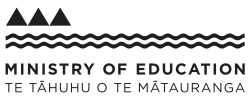Ministry of Education (New Zealand)
 | |
| Agency overview | |
|---|---|
| Formed | 1989 |
| Preceding agency | |
| Jurisdiction | New Zealand |
| Headquarters |
33 Bowen St, WELLINGTON 6140 |
| Annual budget |
Total budgets for 2017/18[1] Vote Education Vote Tertiary Education |
| Minister responsible | |
| Agency executive |
|
| Child agency | |
| Website |
www |
The Ministry of Education (Māori: Te Tāhuhu o te Mātauranga) is the public service department of New Zealand charged with overseeing the New Zealand education system.
The Ministry was formed in 1989 when the former, all-encompassing Department of Education was broken up into six separate agencies.
History
The Ministry was established as a result of the Picot task force set up by the Labour government in July 1987 to review the New Zealand education system. The members were Brian Picot, a businessman, Peter Ramsay, an associate professor of education at the University of Waikato, Margaret Rosemergy, a senior lecturer at the Wellington College of Education, Whetumarama Wereta, a social researcher at the Department of Maori Affairs and Colin Wise, another businessman.[2] The task force was assisted by staff from the Treasury and the State Services Commission (SSC), who may have applied pressure on the task force to move towards eventually privatizing education, as had happened with other government services.[3] The mandate was to review management structures and cost-effectiveness, but did not include curriculum, teaching or effectiveness. In nine months the commission received input from over 700 people or organizations.[4]
The Picot task force released its report Administering for Excellence: Effective Administration in Education in May 1988. The report was critical of the Department of Education, which it labelled as inefficient and unresponsive. The task force conceived of the school charter as a contract between school boards, the local community and central authority and the government accepted many of the recommendations subsequently published in their response - Tomorrow's Schools. This recommended a system where each school would be largely independent, governed by a board consisting mainly of parents, although subject to review and inspection by specialized government agencies. Another recommendation was that boards of trustees were made responsible to the Minister of Education, who gained the power to dismiss boards.
The Picot report became the basis for a drawn out process of educational reform in New Zealand starting in 1989.[5] When National was elected in October 1990, it carried out a further series of educational reviews culminating in the publication Education Policy: Investing in People, Our Greatest Asset. This resulted in further modifications to the structure of education reform, and according to one academic, created "a system which is a far cry from the Picot intentions... There has been an ongoing series of changes and reassessments that has caused chaos, confusion and massive insecurity throughout the education sector".[6]
In March 2013, Patrick Walsh, the outgoing president of the Secondary Principals' Association said that despite having about 3000 employees, the Ministry had underperformed for more than a decade. He said "in an era of self-managing schools we have a Ministry that is so large and yet not able to perform in an effective and efficient manner". Walsh said the Ministry's poor performance has been confirmed by a number of reviews conducted by the State Services Commission.[7]
Responsibilities
The Ministry's role is to raise the overall level of educational achievement and reduce disparity. It is not an education provider. That role is met by individual elected Boards of Trustees for every state school in the country. The ministry has numerous functions - advising government, providing information to the sector, providing learning resources, administering sector regulation and funding, and providing specialist services. The ministry works with other education agencies including the Education Review Office, the New Zealand Qualifications Authority and Learning Media Limited.
Although the Ministry's role is to raise the level of educational achievement, it is also the mechanism through which the Government of the day implements its education policy. When government changes aspects of its policy on education, the Ministry is responsible for implementing those changes. Sometimes the Ministry ends up in the difficult position of trying to implement political induced changes in education policy to which teachers, parents and boards of trustees may be totally opposed. Changes introduced by the National Government in 2011–2012 are an example.
In order for the Ministry to perform its role effectively, it is dependent on taxpayer funding provided by Government. When government increases funding or requires financial cutbacks, this also impacts on the ability of the Ministry to fulfil its role. In 2013, the Government provided about $12.2 billion to fund education in New Zealand.[8]
Ministers
The Ministry serves 1 portfolio, 1 minister and 3 associate ministers.
| OFFICEHOLDER | PORTFOLIO(S) | OTHER RESPONSIBILITY(IES) |
|---|---|---|
| Hon Chris Hipkins | Lead Minister (Ministry of Education) Minister of Education | |
| Hon Kelvin Davis | Associate Minister of Education (Māori Education) | |
| Hon Jenny Salesa | Associate Minister of Education | |
| Hon Tracey Martin | Associate Minister of Education |
See also
References
- ↑ "Total Appropriations for Each Vote". 2017 Budget. The Treasury. Archived from the original on 7 November 2017. Retrieved 4 November 2017.
- ↑ Fiske & Ladd 2000, pp. 48.
- ↑ Roger Dale and Joce Jesson (1993). "Mainstreaming Education: The Role of the State Services Commission" (PDF). New Zealand Annual Review of Education, 7, 7-34. Retrieved 2010-12-13.
- ↑ Levin 2001, pp. 44.
- ↑ Levin 2001, pp. 45.
- ↑ The Myth of Partnership: Educational Reform and Teacher Disempowerment
- ↑ Education ministry 'ineffective'
- ↑ Teachers want Government to 'come clean'
External links
- Official website
- TeachNZ, a business unit of MoE
- Te Kete Ipurangi - The Online Learning Centre, an initiative of MoE
- The Education Gazette, published by MoE
Coordinates: 41°16′32″S 174°46′44″E / 41.275615°S 174.778782°E